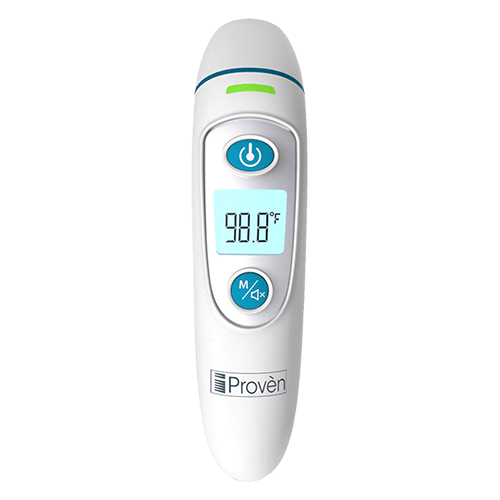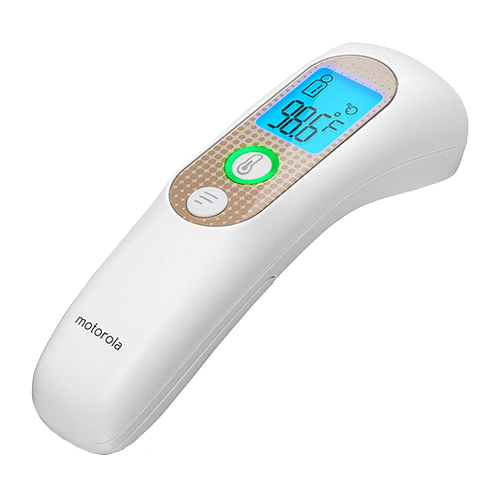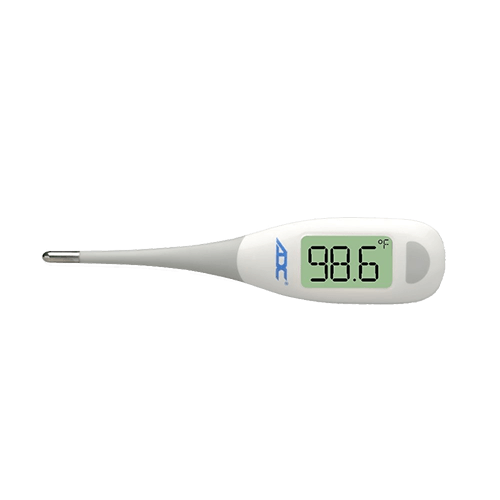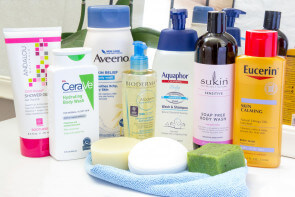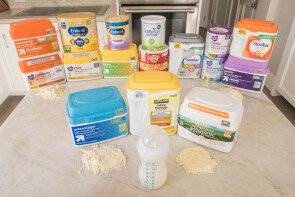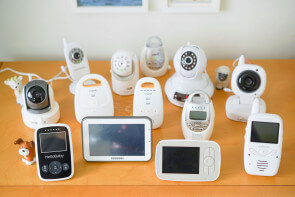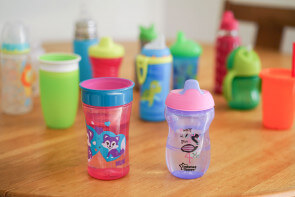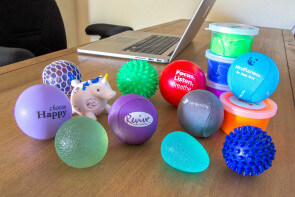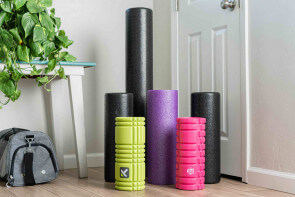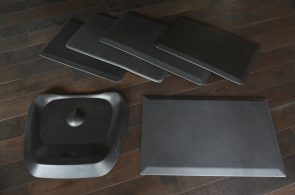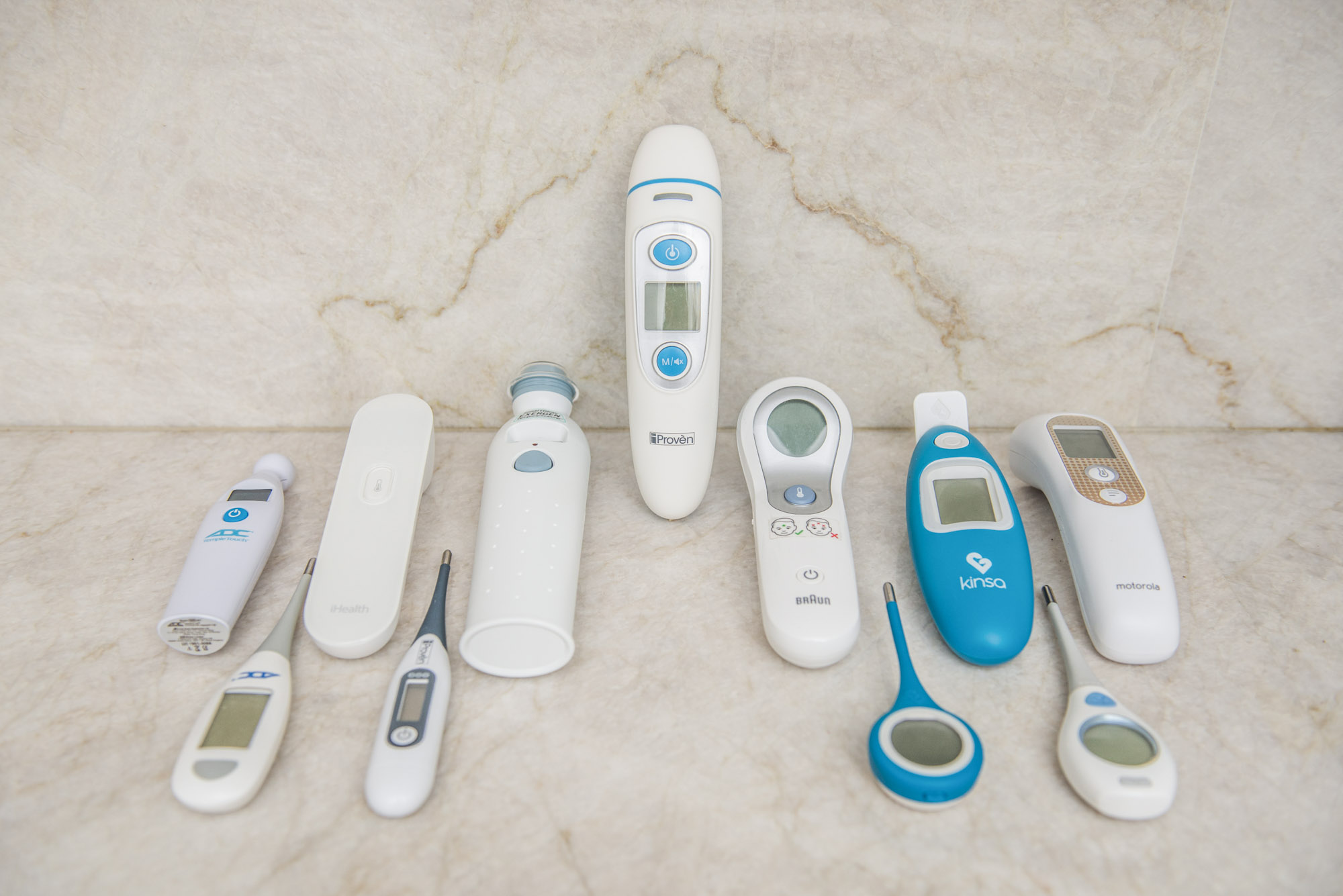
The Best Digital Thermometers for Babies and Kids
After our test family used 11 of the best digital thermometers for tracking body temperature, they chose the iProven – DMT-511 as the best thermometer overall. With easy-to-read temporal (forehead) and tympanic (ear drum) modes, you can confidently tell the difference between low-grade fever symptoms and a high fever. The Motorola – MBP70SN Smart Touchless Thermometer is even better for quickly checking baby and toddler temperatures when your little one just won’t sit still. It’s a good idea to have a traditional probe thermometer on hand, too, and the ADC – Adtemp 418N is both easy to use and reliable.
After our test family used 11 of the best digital thermometers for tracking body temperature, they chose the iProven – DMT-511 as the best thermometer overall. With easy-to-read temporal (forehead) and tympanic (ear drum) modes, you can confidently tell the difference between low-grade fever symptoms and a high fever. The Motorola – MBP70SN Smart Touchless Thermometer is even better for quickly checking baby and toddler temperatures when your little one just won’t sit still. It’s a good idea to have a traditional probe thermometer on hand, too, and the ADC – Adtemp 418N is both easy to use and reliable.
Table of contents
- How we selected products to test
- Compare the best digital thermometers
- Important features to consider
- Understanding fever temperatures
- How we tested
- Best forehead thermometer: iProven – DMT-511
- Best baby thermometer: Motorola – MBP70SN
- A simple probe thermometer: ADC – Adtemp 418N
- Another Probe we liked: Vicks – Rapid Read
- Other thermometers we tested
- The bottom line
How we selected products to test
During nine hours of careful research, we read recommendations from health agencies, reviewers like Consumer Reports, Wirecutter and Baby Gear Lab, parenting magazines and blogs.
Our researcher spoke with nurses at his children’s pediatrician’s office (part of the St Joseph Medical Group in Orange) as a part of the research for this review. He also interviewed Naomi Jackson, a mother of four and a registered nurse working at Killam General Hospital, about her own experiences and preferences. We checked all of these front-line perspectives against the guidelines of the American Academy of Pediatrics (AAP).
After we collected a list of favorite types and model numbers, we checked our list against retailer listings. We checked Amazon to see which models are best-selling and have the highest average review score, but we also looked for updated versions of the best sellers.
In addition to popular consumer retail websites, we looked at medical-supply catalogs to see where professionals are getting their gear. We didn’t buy any clinic-grade thermometers that cost over $300, but we noted the prominent manufacturers and found some good examples of home-use thermometers based on technology developed for the clinic.
Compare the best digital thermometers
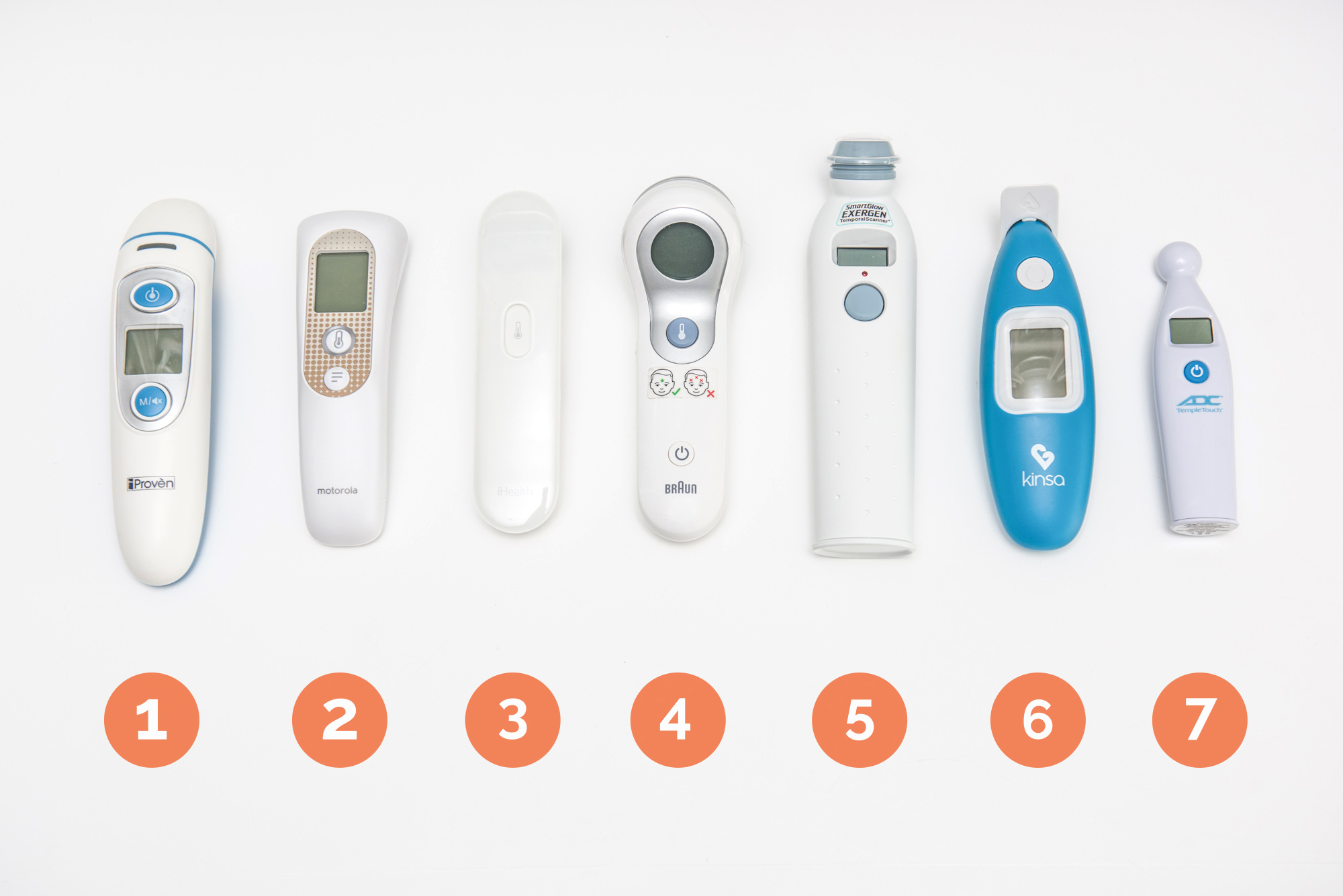
| Thermometer | Price | Type | Versatility | Confidence | Easy to Use? |
|---|---|---|---|---|---|
| Forehead and Ear Thermometers | |||||
| 1. iProven - DMT-511 | $$ | Forehead and Ear | ☆☆☆ | ☆☆☆ | ☆☆ |
| 2. Motorola - MBP70SN | $$$ | Forehead - Instant | ☆☆ | ☆☆ | ☆☆☆ |
| 3. iHealth - PT3 | $$ | Forehead - Instant | ☆ | ☆☆ | ☆☆☆ |
| 4. Braun - NTF300US | $$$$ | Forehead - Instant | ☆ | ☆☆ | ☆☆☆ |
| 5. Exergen - TAT200c SmartGlow | $$ | Forehead - Scan | ☆ | ☆☆☆ | ☆☆ |
| 6. Kinsa - Smart Ear Thermometer | $$$ | Ear w/Bluetooth | ☆ | ☆☆ | ☆☆ |
| 7. ADC - Temple Touch | $ | Forehead - Contact | ☆ | ☆☆ | ☆☆ |
| Probe Thermometers | |||||
| 8. ADC - Adtemp 418N | $ | Probe | ☆☆☆ | ☆☆☆ | ☆☆☆ |
| 9. Vicks - Rapid Read | $ | Probe (3 modes) | ☆☆☆ | ☆☆☆ | ☆☆ |
| 10. Kinsa - QuickCare | $ | Probe w/Bluetooth | ☆☆☆ | ☆☆☆ | ☆☆☆ |
| 11. iProven DT-R1221AWG | $ | Probe | ☆☆☆ | ☆☆☆ | ☆☆☆ |
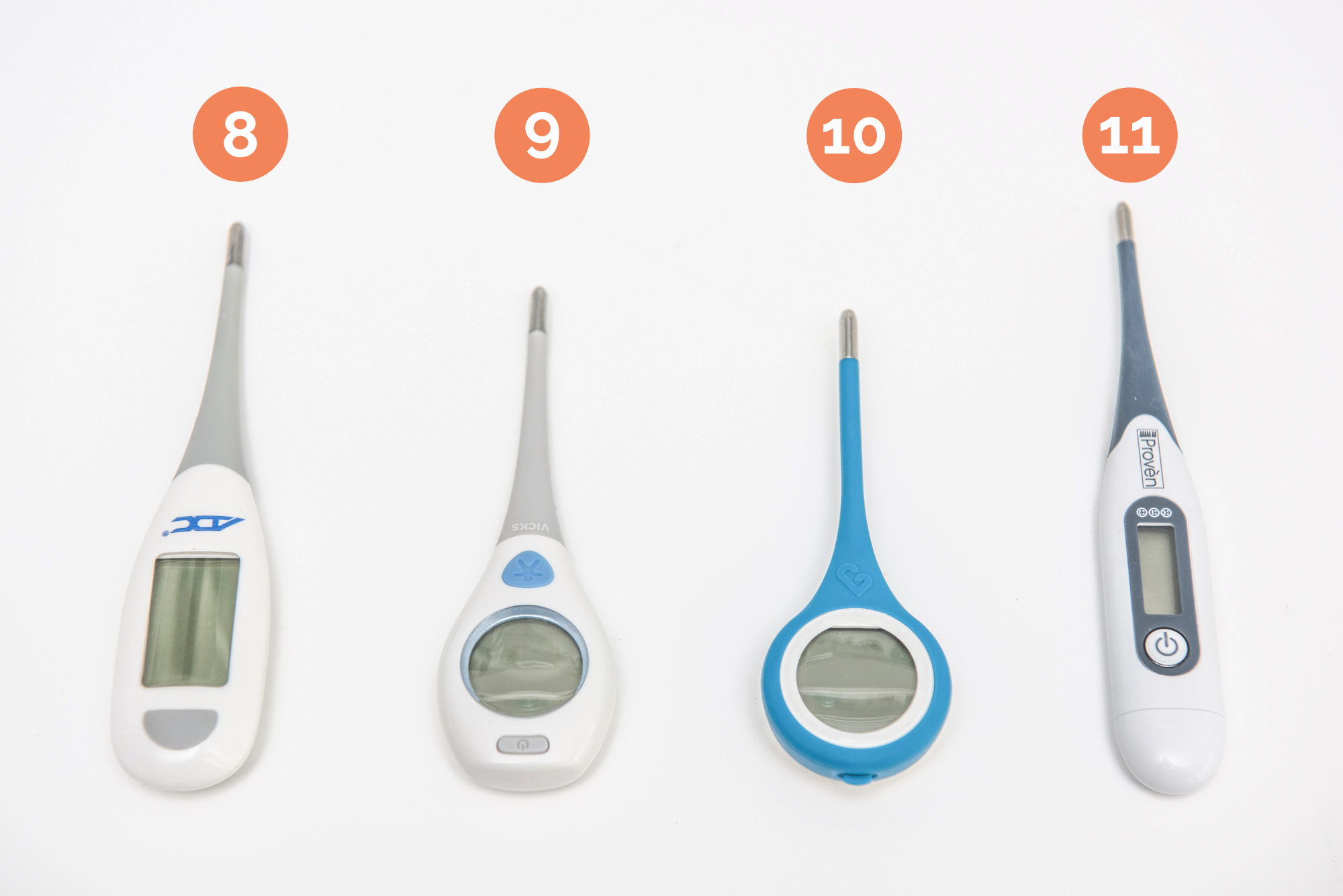
Important features to consider
Fever indicator guides: Most new thermometers use symbols or colors to tell you if a body temperature is within normal range. If the temperature is a low grade or high fever, colored lights or other indicators will notify you. If you don’t have time to look up temperatures on a chart, then these color-coded fever warnings might be helpful. It’s still a great idea to check and write down the body temperature of your family members (and yourself) on a day when you’re not sick, so you’ll have a better idea of how severe a fever is. Find out what range the thermometer considers normal and severe, and remember that the temperature ranges are different for a baby.
Predictive vs. live monitor readings: All the thermometers we bought are “guessing” at a body temperature reading. For example, probe thermometers don’t actually wait for the metal tip to reach a stable temperature, they guess based on known temperature curves in typical scenarios.
It sounds tricky, but it’s been proven accurate and is much quicker than waiting for a thermometer to come up to your actual temperature. If you want to monitor changes in real time, you’ll need to make sure you buy a monitoring thermometer and learn how to use it.
Actual vs. compensated reading: Like predicted temperatures for probes, most forehead thermometers are adjusting their temperature reading by a few degrees to tell you what a person’s oral reading should be. Again, this is fairly accurate, but you should understand what the number actually means.
Types of thermometers
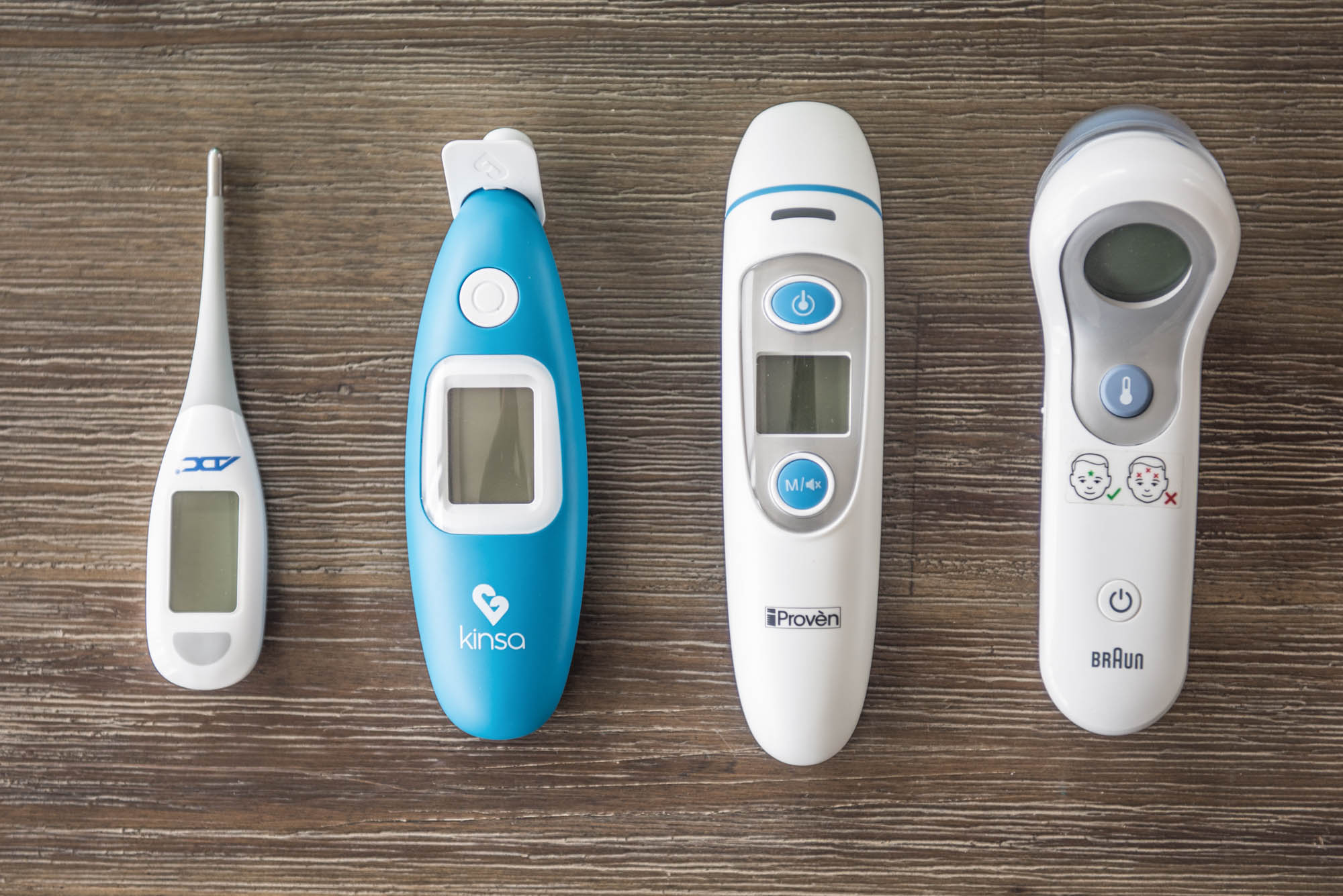
The most difficult part of buying a thermometer is deciding which type will serve you best. There are pros and cons for each type, and they will all let you down if you don’t learn how to use them consistently.
After testing a wide range of types we feel comfortable with both scanning and instant forehead thermometers as the easiest to use.
If you want something that’s more bulletproof, probe thermometers basically never give a false reading, though you still need to know where to put them to get a consistent temperature.
Probe thermometer
A digital version of the mercury-in-glass thermometers used a century ago, these thermometers are still incredibly popular. For adults, a probe thermometer under the tongue is an easy way to get a reliable temperature.
For infants and children younger than 3, the American Academy of Pediatrics (AAP) recommends taking a rectal temperature if you want the most accurate reading, though one nurse we spoke with said she would never ask a parent to take a rectal temperature.
Pros:
- Probe thermometers can give very reliable readings.
- This type is the least expensive.
- They’re also easy to carry in a diaper bag.
Cons:
- Two words say it all: rectal probe.
- Oral readings are tricky with squirming kids or babies.
- Oral temperatures are not considered reliable in babies before six months of age.
- Axillary (armpit) temperatures aren’t as consistent as other methods.
- Having multiple thermometers, or at least disposable covers, is essential if you’re sharing.
Pacifier thermometer
This is just a probe thermometer built into a pacifier, so you’ll at least have a fighting chance of getting an infant to keep it in his or her mouth.
Pros:
- A pacifier can be much easier to get your baby to accept than a regular thermometer.
Cons:
- Accurate readings through a pacifier nipple require up to five minutes of sucking to verify temperature.
- Professionals don’t recommended oral temperature for checking newborns.
We looked at the pacifier thermometers available and were disappointed by long read times and tiny displays. Pacifier models are also missing extra features we’ve come to expect from other thermometers. Reviews were quite negative, so we didn’t test any.
Ear (tympanic) thermometer
Reading the eardrum with an infrared sensor is quick, but you have to get a clear shot at it. Studies have shown that newborns often have ear canals that are too small to allow this type of thermometer to work effectively, so it’s only recommended after six months. Even then, the nurses we talked to still find this type frustrating on occasion.
Pros:
- Readings for kids and adults can be very accurate.
- They’re quicker than oral measurements.
Cons:
- Earwax can lead to inaccurate readings.
- Readings for infants younger than six months are not considered reliable.
- Some people hate having things in their ears.
Scan-type forehead (temporal) thermometer
This type of thermometer uses either an infrared sensor or a metal contact patch with a thermal probe behind it to measure the temperature of your forehead, specifically the blood flowing through the temporal artery on your temples. This involves scanning over a fairly wide area to get an average temperature, usually for just a few seconds with infrared scanners.
Pros:
- This is fast and non-invasive.
- Studies show this is usually a reliable way to judge body temperature.
Cons:
- It’s hard to know when you’re using a forehead thermometer wrong.
- Scanning the forehead still takes 2-3 seconds.
- Babies may not hold still enough for this to work well.
- These models require skin contact.
Non-contact forehead thermometer
Like the above forehead thermometers, this type measures skin temperature to estimate the temperature of blood inside your temporal artery. The distinction is that this new style measures over a wider area instantaneously, so it doesn’t have to touch your skin.
This type of thermometer is so quick, you might doubt its accuracy. That said, it’s fast enough to be very easy to use. It’s also the thermometer least likely to wake someone. It’s also important to make sure the forehead is clean and dry before using this type.
Pros:
- Hands down, this is the fastest way to take a temperature.
- No skin contact is required to take a reading.
- You can take readings without waking someone up.
Cons:
- This type is the most expensive.
- You still need to practice measuring the same spot each time.
- These thermometers have the most buyer complaints about inconsistent readings.
Understanding fever temperatures
| Age | Low Grade Fever | High Fever |
|---|---|---|
| Infant | 100.4 | 100.4 |
| 3-6 Months | 100.4 | 102 |
| 6 months to 13 years | 100.4 | 103 |
| 14-64 years | 100.4 | 103 |
| 65 years or older | 100 | 101 |
| Measurements in fahrenheit based on an average of oral temperatures, rectal will be ~0.5° degrees higher, armpit or forehead ~1–1.5° degrees lower. | ||
| Source: AAP, AAFP | ||
Generally speaking, physicians consider temperatures above 100.4 degrees Fahrenheit to indicate a fever. That means the body’s metabolic system has raised its temperature to respond to illness. 100.4 is 2.2 degrees higher than the average temperature of 98.2.
That’s a guideline for clinical practice, but the range of normal temperatures in different people is wide. The range in adults goes from about 97 to 99, so if your normal body temperature is on the low end, an equivalent to the standard fever reading would be just 99.4.
Babies tend to be slightly warmer, and after age 65, our bodies stay cooler on average. In those age ranges, doctors advise paying extra attention to a fever and any other symptoms.
if you’re going to buy and use a thermometer, you owe it to yourself to find out what your (or your child’s) normal temperature range is. Most of the manuals we read recommended to check at the same time of day over a few days.
Once you learn how your thermometer works and what your normal temperature is, you’ll be better prepared to take accurate readings when you’re sick.
What to do about a low-grade fever
If you’re not seeing any problematic symptoms, most doctors will prescribe rest and possibly pain-relieving drugs. The American Academy of Pediatrics issued a report in 2011 that makes a very clear statement about fever and fever-reducing drugs:
“Fever is a physiological mechanism that has beneficial effects in fighting infection. Although many parents administer antipyretics (medications to reduce a fever) such as acetaminophen or ibuprofen to a child to reduce a fever, the report emphasizes that the primary goal should be to help the child feel more comfortable, rather than to maintain a “normal” temperature.
- Parents should focus on the general well-being of the child, his/her activity, observing the child for signs of serious illness and maintaining appropriate fluid intake.
- Parents should not wake up a sleeping child to administer a fever-reducer. Antipyretics must be stored safely to avoid accidental ingestion.
- Parents should be aware that the correct dosage is based on the child’s weight, and that an accurate measuring device should always be used.”
A nurse’s perspective
We talked to Naomi, a mother of four who works as a Registered Nurse in the emergency room at a small hospital in rural Alberta, Canada. We asked her to compare what she uses at work and at home.
Naomi’s hospital uses a clinic-certified model from Exergen, fairly similar to the TAT200c we tested. The nurses rely on a probe thermometer if they have doubts: “If we’re not sure of accuracy and the child is symptomatic we just go to the axilla (armpit) after [a forehead scan].”
For home use with her four kids, Naomi bought an ear-reading infrared thermometer, but she says it’s not as reliable as some would have you think: “Even the hospital grade in-ear thermometers are way off sometimes. User variations—getting it in exactly the right place in the ear, pulling the lobe just right to position the canal, etc… that make it less accurate. If I was to get a second thermometer for home I would get a temporal [forehead-type].”
We asked Naomi how they check temperatures in the ER for infants, given all the studies that suggest a rectal thermometer is the only one that’s really accurate. “Rectal is considered the most accurate of any measurement,” she says, “but also has the most risk of harm. Nurses are not allowed to take rectal readings without a doctor’s order, and it is hardly ever necessary to have a reading that accurate. I would never recommend rectal to a parent.”
Finally, we asked her what kind of device would give the most helpful information to a parent when talking with a nurse, and she laughed. “If I call in to Health Link [a telephone medical advice service in her area] the nurses always make me retake the temperature with a probe thermometer under the arm before they will give advice.”
So, whatever thermometer you pick, read the instruction manual carefully, and learn how to take consistent readings. Also, don’t be surprised if a nurse tells you to use a cheap probe thermometer under your baby’s arm.
How we tested
Our test family consists of two adults, a three-year-old, and an eight-month-old. They’ve used a variety of thermometers over the last three years, including a non-contact forehead thermometer and a few cheap probe thermometers.
Our testers used most of the thermometers a few times for checking cold symptoms, but mostly they took normal readings and relied on controlled tests to see how the thermometers responded to elevated temperatures.
Normal temperatures among our testers ranged from 97 degrees Fahrenheit to 98.5.
Note that our tests show, as expected, all of these thermometers are calibrated from the factory to give valid readings. You’ll need to learn how to interpret those readings for a thermometer to be useful.
For example, the red fever indicator light on some thermometers shows up at 99.5, while on others that temperature would trigger an “elevated” indicator with a “high” fever light reserved for 102.6.
Different test sites (forehead, ear and mouth) also show different temperatures, and some thermometers even convert a “raw” reading into an equivalent for what you would likely see with a different thermometer.
So if you want to know if a fever is serious, it’s important to know how much higher your temperature is, compared to a thermometer reading when you’re definitely healthy.
| Thermometer | Easy to Use? | Speed | Consistency (change across readings) | Difference from Oral Reading (°F) |
|---|---|---|---|---|
| Forehead and Ear Thermometer | ||||
| iProven - DMT-511 | ☆☆ | ☆☆ | -0.3 | 0.90 |
| Motorola - MBP70SN | ☆☆☆ | ☆☆☆ | 0 | 0.70 |
| iHealth - PT3 | ☆☆☆ | ☆☆☆ | -0.3 | 0.90 |
| Braun - NTF300US | ☆☆☆ | ☆☆☆ | -0.1 | 1.70 |
| Exergen - TAT200c SmartGlow | ☆☆ | ☆☆ | -0.2 | 0.60 |
| Kinsa - Smart Ear Thermometer | ☆☆ | ☆☆ | 0.2 | 0.40 |
| ADC - Temple Touch | ☆☆ | ☆ | -0.4 | 0.57 |
| Probe Thermometer | ||||
| ADC - Adtemp 418N | ☆☆☆ | ☆☆ | 0.2 | -0.42 |
| Vicks - Rapid Read | ☆☆ | ☆☆ | 0 | -0.04 |
| Kinsa - QuickCare | ☆☆☆ | ☆ | -0.3 | -0.47 |
| iProven DT-R1221AWG | ☆☆☆ | ☆ | -0.4 | 0.14 |
Ease of use and read time
Each thermometer type works a little bit differently, so we measured the time between turning the thermometer on and a final temperature reading.
The real winner is, again, the instant-scan Motorola, iHealth and Braun. The read time really is instant, and that can make all the difference if you’ve got a fussy baby. For taking temperatures on yourself or an older kid, it’s not as much of an issue, but the speed is still nice.
An uncooperative baby or toddler presents two problems when you’re taking a temperature. First, they don’t sit still. Second, they often don’t want you to touch them with the thermometer.
Non-contact thermometers are the real winners in this test as well, since they give readings instantly and don’t need to touch your kid’s skin. If you have a two-year-old throwing a tantrum that might not be enough, but at least you’ve got a fighting chance.
The other thing to note about testing with babies is that you need to be more aware of exactly what counts as a fever. See our section on understanding fever temperatures.
Accuracy: water bath
Many purchasers who leave low-score reviews complain about the difficulty of getting consistent readings with forehead thermometers, and the same is sometimes true of ear thermometers. Basically, the more reviews a thermometer has, the more likely someone has complained about it.
The fact that many thermometers aren’t giving you a “true” reading doesn’t help: Braun quickly points out when asked that their readings are factoring the temperature from your whole forehead and predicting your body temperature, rather than just giving you a simple reading.
For our first accuracy test, we used a warm water bath and a large cast iron pan to get a stable temperature. Our reference was a calibrated alcohol-filled thermometer with traceable certification to half a degree Celsius. Agitating the water constantly to keep the temperature stable, we checked the temperature of the water for probe thermometers or the iron surface for infrared-reading models.
In our chart, we recorded averages of high and low readings. All of the probe thermometers were very accurate, but three readings from the Vicks – Rapid Read varied the least averaged to just over a tenth of a degree from the calibrated reference across three tests.
If tallying up the error margin (or “delta”) on each reading, then averaging the amount of error per reading, the Kinsa – QuickCare squeaks ahead by a few decimal points.
Suffice it to say, probe thermometers are carefully calibrated from the factory and are probably more accurate than our bath setup is capable of testing.
Many of the infrared thermometers would not accept the metal surface or the surface of the water to give a reading. Two models would test in “object” mode (advertised as a way to check bath and bottle temperatures) but were more than four degrees off.
Accuracy: body temperature
We checked accuracy with all of the forehead and ear thermometers against a rectal temperature reading. The most accurate body temperature readings came from the Exergen – TAT200c SmartGlow, but that’s partly because the directions for that thermometer suggest averaging forehead measurement with a reading behind the ear.
The only device that was more than one degree off was the Braun – NTF300US, but it gives a reading that’s one degree cooler than every other thermometer. That’s closer to an armpit measurement, rather than an oral measurement equivalent we expected.
Again, numerical accuracy isn’t a problem if you’ve taken the time to find out what your normal body temperature reads as with the thermometer you buy, since all the models we tested are all very consistent. But it could be confusing if you were worried about a fever, bought the thermometer, saw a “low grade fever” 100.4 reading and then checked it again with a different method and saw 103.4.
Consistency
As expected, all the thermometers were very consistent. We tested multiple readings with the same subjects, being careful to check as consistently as we could with each model. We used one infant and two adult subjects for repeat tests to nail down consistency.
Most thermometers came in at 0.2 or 0.3 degrees change over three readings. The highest variability came from contact-reading thermometers, but two thermometers achieved a totally steady reading over three closely-spaced readings with multiple subjects: The Motorola Baby instant-read and Vicks probe thermometers.
Best forehead thermometer: iProven
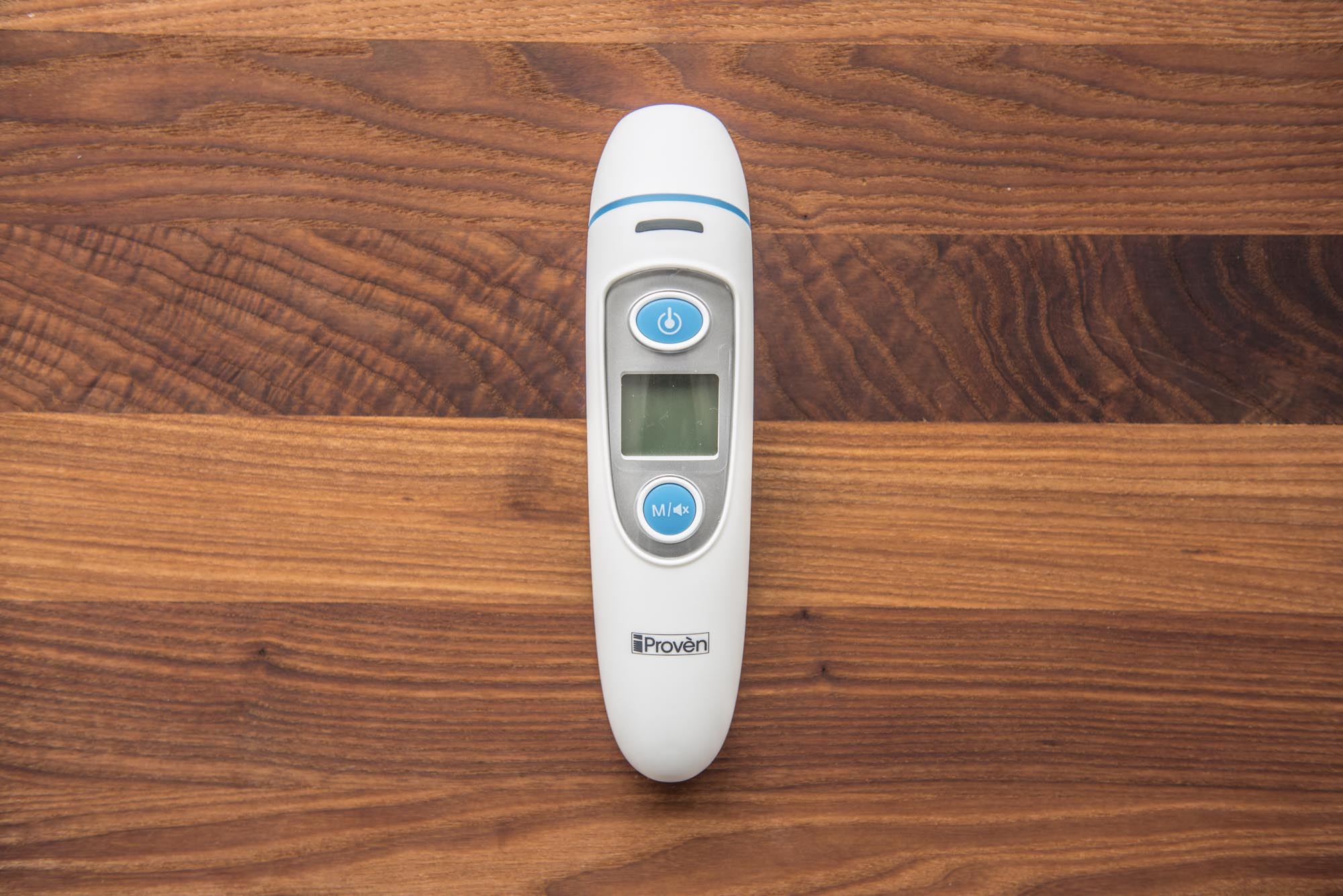
The iProven – DMT-511 is a new update to a best-selling thermometer design. As the only combination forehead-and-ear thermometer on our list, it’s also more versatile. If you want the ability to back up a forehead scan with a different type of measurement in case you get a strange result, iProven has you covered.
A perennial best-seller, iProven has clinched recommendations from the likes of Wirecutter, Babylist and The Bump with their old DMT-489 model. The 511 is slightly sleeker and easier to use: older models had separate buttons for forehead and ear readings and relied on combination presses for other functions.
The new design uses the cap to detect which mode you’re using, and just one “take temperature” button. There’s a designated function button for mute and memory options. You still need button combinations to change scales and switch to object measurement mode, but it’s a better interface than the old models.
In use, the iProven is accurate and easy to use. In forehead mode (with the cap on) you need to hold down the read button and swipe the reader across your forehead.
The swipe-scanning motion does take longer than an instant-scan touchless thermometer like our runner-up. If you’re dealing with a baby that’s thrashing, even the two-second swipe might be frustrating. The iProven is still a good thermometer for babies, but this is mostly the best digital thermometer for adults or kids.
Measuring the temperature of the eardrum is also easy: Pop off the cap, insert the tip carefully into the ear canal while pulling back on the earlobe, and press the button for an instant reading.
If you’re averse to objects going into your ears you might skip that mode, but it works as well as the forehead scan. In our tests, the eardrum temperature was on average 0.2 degrees cooler than the forehead, which indicates the thermometer is compensating to give similar readings with both methods.
Some people will already be looking up a chart to interpret between different types of thermometers, but you can rely on this thermometer to give you a number consistent with what you’d get from skin temperature under the armpit.
Best Buy: iProven - DMT-511
This thermometer is a simple, reliable forehead-scanning model that only takes a few seconds to use. It's not the fastest thermometer, but the bonus of a back-up ear scan method is good for peace of mind if you get a strange reading. A bargain price and all the options you could ask for rounds out its feature list.
Memory for the last 35 readings is available at the push of a button. That’s a handy feature if you’re tracking a fever as it runs its course, though it doesn’t give you an at-a-glance overview as an app or even a paper notebook would. It’s a less-useful feature if you use the thermometer for more than one person, since you’d quickly lose track of which readings belonged to each person.
This model also includes a mode to scan baby bottles and bath water—hold down the function button when the thermometer is powered off to activate this mode—though somehow it was off by eight degrees. Don’t buy this thermometer for kitchen or laboratory use; instead, check out our meat thermometer and Thermapen reviews for devices with that kind of accuracy.
Happily, iProven includes a mode to adjust the built-in temperature compensation by up to two degrees, which means you can fine-tune the reading to better match a reference reading using a different kind of thermometer.
Changing between Fahrenheit and Celsius is handled with a toggle switch inside the battery compartment, which is definitely our favorite method. To mute the confirmation beep that sounds with every reading, hold down the mode button with the “memory/mute” symbol.
After comparing the field, we were won over by the simple controls, reliable reading and low price of this model. The eardrum mode is a nice perk; most of us shouldn’t need it, but if your patient’s forehead is covered in sweat or dirt it’s nice to have a back-up method.
Key takeaways:
- The forehead scan mode of the iProven – DMT-511 gives quick, accurate measurements, so long as you use it consistently.
- If you ever doubt a forehead reading, the eardrum mode is a handy backup method.
- Silent mode is also easy to activate.
- No Bluetooth or profiles means less frustration.
- 35 past-temperature memory, but no profiles for individual family members.
- Not as quick or simple as an instant-read model.
Best baby thermometer: Motorola
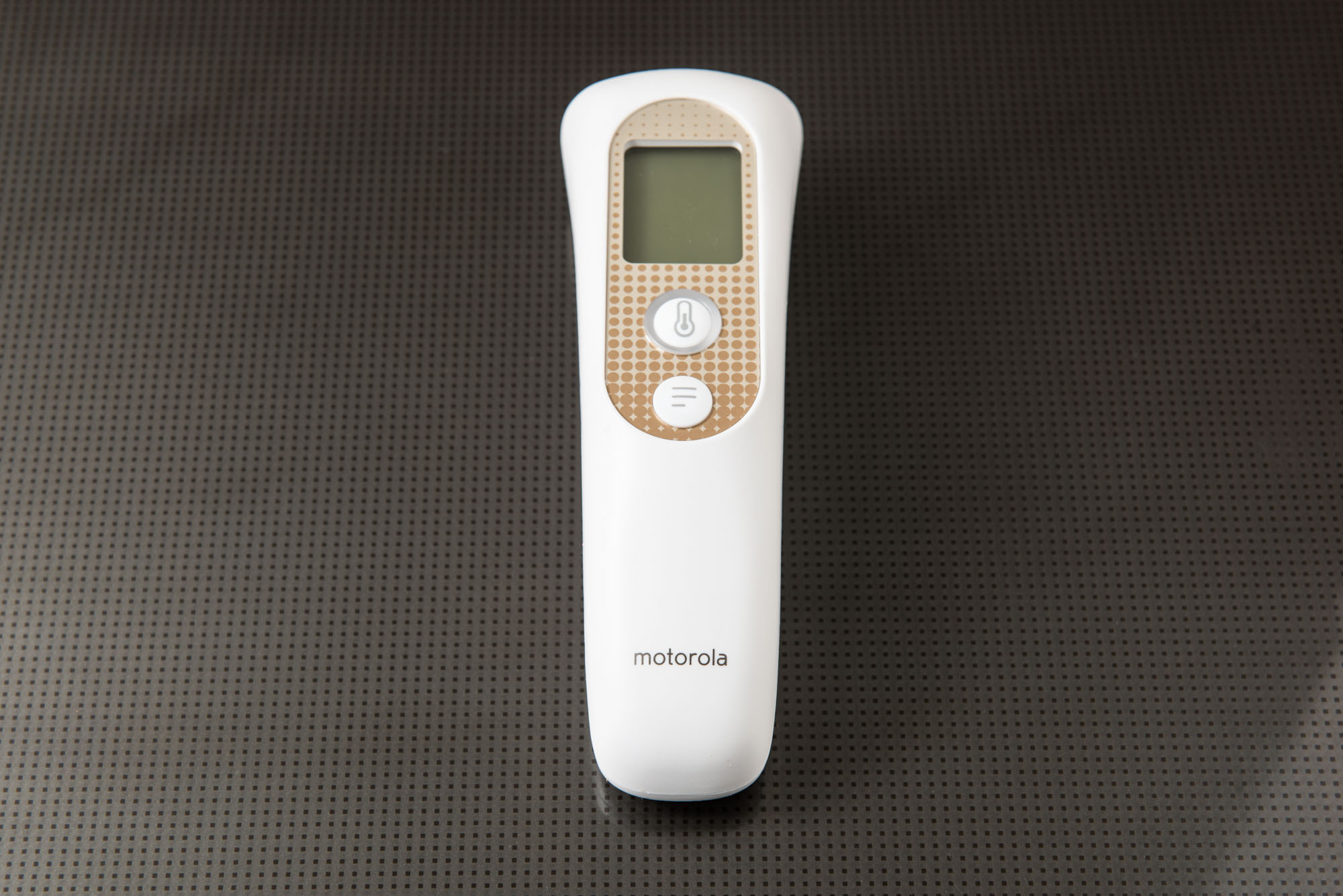
If you’re looking for a thermometer to add to your baby registry, the Motorola – MBP70SN Smart Touchless Forehead Thermometer has a few advantages over the iProven.
First, the Motorola scans from up to two inches away from the center of the forehead, no touching necessary. Second, the Motorola gives a measurement instantly, and there’s no need to practice side-to-side scanning. It’s much easier to get readings from a fussy baby or a toddler this way.
Beyond those clear benefits, the Motorola is a mixed bag. You give up the ear scan feature that makes the iProven more flexible, though remember that ear scans aren’t considered accurate until six months anyhow.
Motorola doesn’t include a silent mode for this thermometer either. If you’re checking someone who’s sleeping, the “didi” beep is not excessively loud, but it’s there. There’s no guarantee it won’t wake a light sleeper.
For taking the temperature of a wriggly baby, an instant scan is as good as it gets, but sometimes even that isn’t fast enough to make your job easy.

Not just for babies
A non-contact thermometer is easier for everyone to use, not just for parents of newborns. If you’ve got a mirror, the point-and-click method is even easy to use on yourself. If you’re used to taking a temperature with an oral thermometer, you might consider the touchless design a waste of money, but it’s definitely convenient.
Are apps and profiles worth it?
Motorola gives you profiles to track temperatures for four users, which means more button-press combinations to remember if you want to get the most out of this model.
A Bluetooth connection links your thermometer readings with the “Hubble Connect for Smart Nursery” app. It’s a decent way to see a trend line, manage profiles and set medication reminders but not much else.
If you’re also using another Motorola Baby nursery device, like a baby monitor or humidifier, you can use the same app rather than install something new for each device. It’s still an app that we don’t think is necessary. Our test for a data-collection app is whether it lets you do something more easily than a paper notebook would, and in this case a notebook in the medicine cabinet (or just making entries on your phone’s calendar app) works better.
Sharing temperatures by email didn’t actually work when we tested that feature with Gmail on an Android phone.
Switching profiles on the thermometer takes a few seconds, so we wouldn’t blame you for just taking readings without switching every time. If you’ve got four babies and you really want an accurate historical record, the app is required to move temperature readings between profiles. You can’t see profile names on the thermometer, either, just numbers.
Most parents aren’t going to need this kind of record, but it does make the memory feature useful with more than one person.
For Baby: Motorola - MBP70SN
Touch-free thermometers are very fast, but some people doubt their accuracy. After hundreds of measurements and checking against our reference thermometer, we didn't see any errors, and we've grown to appreciate how easy it is to check babies with this type. The app isn't as useful as we'd hoped, but you don't need to install it for the thermometer to work.
Fast and accurate
The Motorola was slightly more accurate and more consistent for us than the iProven – DMT-51. It’s fast and very easy to use, as long as you’re not stuck trying to remember which person in your household is assigned each profile slot.
At the end of the day, if you’re OK with ignoring the extra features, or if you actually want to track temperature readings on a graph, this is a great thermometer. The basic measurement function works right away without your pressing any menu buttons.
If you’re not worried about waking a sleeping baby, the non-contact design isn’t worth the doubled price. In addition, Motorola uses a method that’s less well-proven to determine body temperature from your forehead, and in certain cases, there could be factors that lead to problems with accuracy.
If you want measurements you can feel 100-percent confident about, we’d still advise that you have a backup conventional probe thermometer like the ADC. If you’re talking to a doctor’s office on the phone, they’ll likely ask for that type of reading, even if you have detailed charts that track your temperature hour by hour.
Key takeaways:
- When it comes to quick readings, the Motorola – MBP70SN Smart Touchless Thermometer is nearly impossible to beat.
- This thermometer was very accurate and consistent in our tests with all ages.
- The extra features and app only give you better access to stored measurements, they don’t make this a better thermometer.
- If you’re skeptical of instantaneous no-contact readings, you’ll want to have a backup thermometer on hand as well.
A simple probe thermometer: ADC
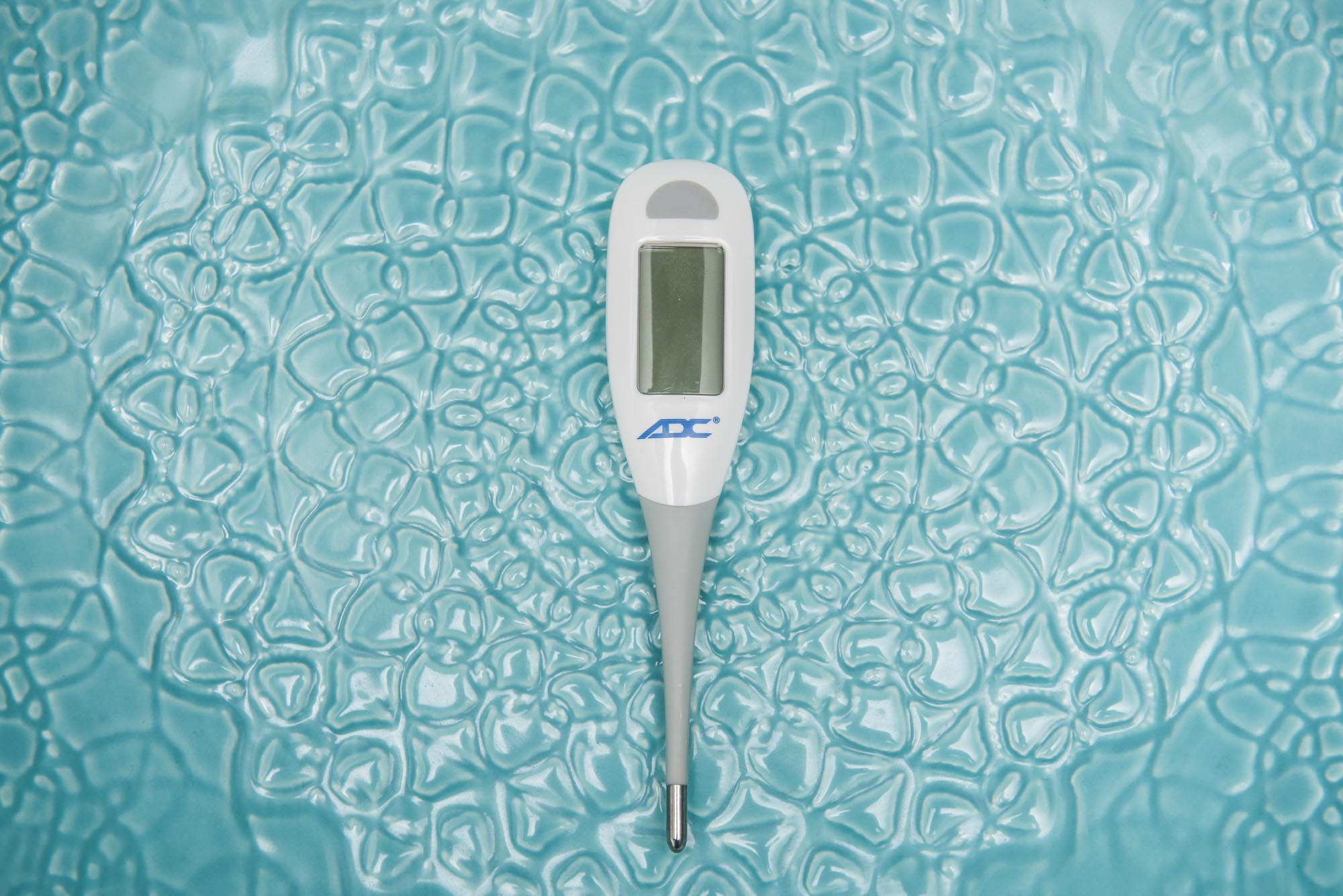
If you want an easy-to-read and fairly speedy thermometer that just does what you’d expect, the ADC – Adtemp 418N is an easy recommendation.
A probe thermometer is only as accurate as your technique, though. If you don’t learn how to put it in the right place under your tongue or armpit, you might get an inconsistent reading. Rectal readings are generally very consistent, but there’s some risk of injury if you’re not careful.
Probe thermometers are carefully calibrated, as our tests in a water bath against a certified lab thermometer confirmed. The most variation we saw between readings from any of this style of thermometer was 0.38 degrees, and our top pick averaged to 0.31. Our ability to maintain the conditions of the test was almost certainly worse than the thermometer itself.
What sets the ADC probe thermometer apart from the competition is simplicity. The only option you have to worry about with this thermometer is switching between Celsius and Fahrenheit scales. (While the thermometer is off, press and hold the power button until the scale symbols start flashing; press the power button to switch, then wait for it to power off.)
ADC upgrades this model over older models with a fever warning via a colored backlight. That’s a nice perk, but the bigger selling point for us is the quick read time and easy-to-see numerals.
After you press the power button, you’ve got about 10 seconds before a reading is confirmed. That’s not as fast as the lightning-quick Vicks – Rapid Read system, but with the ADC you don’t need to confirm which site you’re using every time you turn it on. For an oral temperature check, the overall time between power-on and a verified temperature is surprisingly close between these models, even if the Vicks thermometer spends less time in your mouth.
If you don’t know what your regular and elevated body temperatures are, then the color-coded fever warning might be helpful. It’s still a great idea to check and write down the body temperature of your family members (and yourself) on a day when you’re not sick, so you’ll have a better idea of how severe a fever is when it hits.
Five latex-free probe covers also come with this thermometer, and those are a must-have if you think you might ever want to do a rectal probe and then use the thermometer for anything else ever again.
Even if you’re just sharing a thermometer among your kids for oral readings, the covers are still good to have on hand. Probe thermometers are washable, but you can’t immerse any of the models we tested in boiling water for sterilization. Fortunately, probe covers are universal-fit and available in drugstores.
The ADC briefly shows the saved records of the last reading taken when it powers up. This is just about perfect for tracking the course of a fever over a night. It’s not a replacement for writing down a normal temperature or a long-term record of changes, but it doesn’t require extra button-presses or troubleshooting a Bluetooth connection.
The thermometers we tested aren’t likely to be significantly more accurate than what you can find at your corner drugstore, and you could probably get a bare-bones thermometer for free if you ask around. Still, it’s nice having a model that’s easy to read and gives you quick results.
Key takeaways:
- The ADC – Adtemp 418N probe thermometer is quick and simple to use.
- Big, bold numerals are easy to read.
- A temperature check takes about ten seconds, much quicker than most cheap thermometers.
- The colored fever indication backlight is helpful, but it’s no replacement for knowing your own normal range.
- A last-temperature display can help you track the progress of a fever, but it only shows for a second.
Another good probe: Vicks
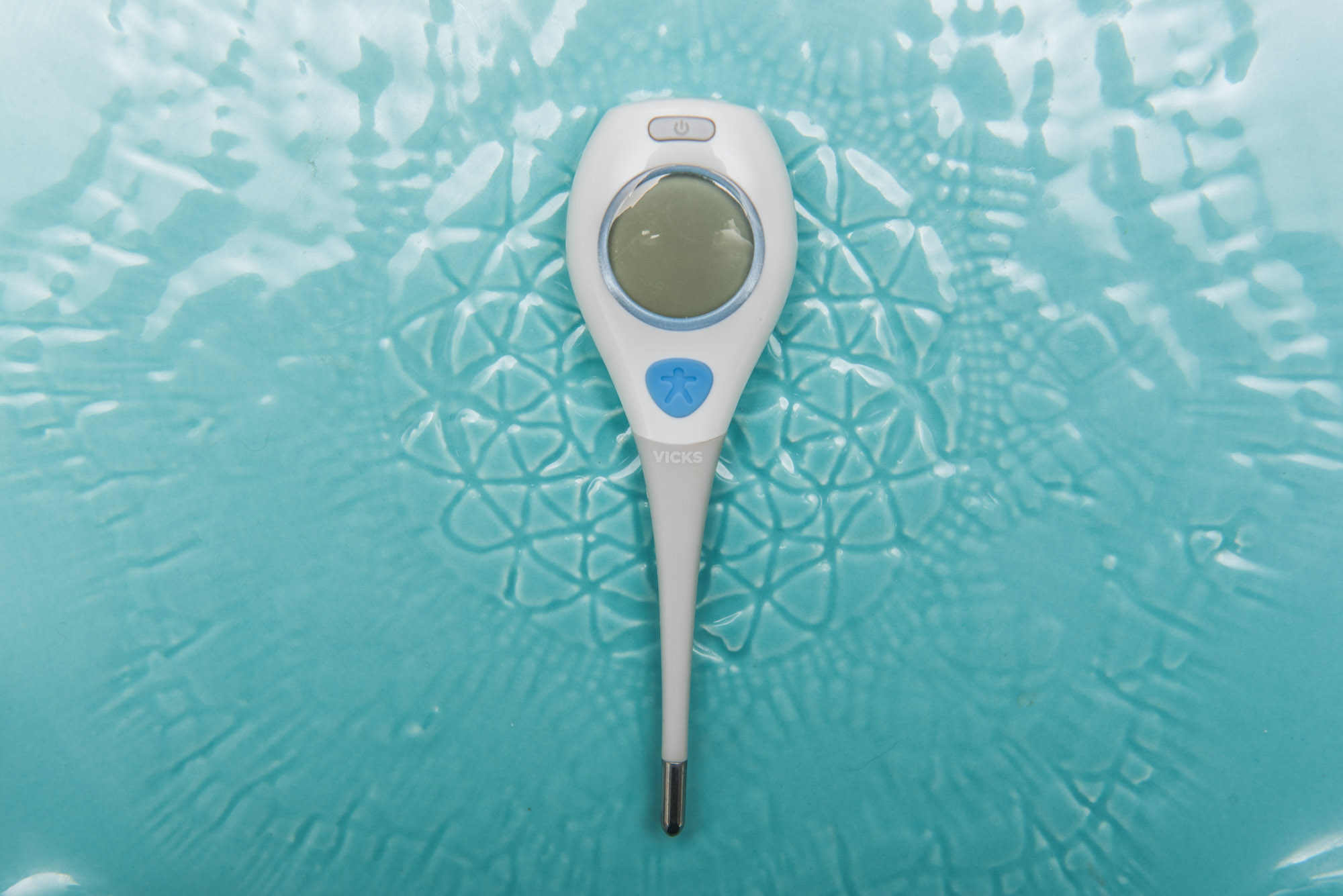
Of the probe thermometers we tested, the Vicks – Rapid Read was the closest to earning a recommendation. Technically, it’s faster than the ADC if you’re doing an oral temperature check under the tongue: Once it’s ready, it only takes two seconds to give an accurate, consistent reading. That’s very impressive. But the whole power-on process takes about the same amount of time as other quick-reading thermometers.
In order to give that accurate reading, this model needs to know what part of your body you’re checking. There’s a three-second wait as the thermometer asks you to press the blue mode button if you want to choose a different location, or leave it on the default. The instruction manual also tells you how to change the default site from oral to armpit or rectal modes.
In all, the startup sequence takes eight seconds. When you add that time to a two-second oral temperature check, any speed advantage it has over other thermometers disappears. It spends less time in your mouth, but it wouldn’t be as intuitive if you handed it to someone who had never used it before.
Reliable but Complicated: Vicks - Rapid Read
If you want a thermometer that translates the difference between mouth, armpit and rectal temperature checks, this model is dead-on accurate. Those options make it more complicated to use, though, and we were left wishing for a simpler thermometer most of the time we used the Vicks.
Readings also change based on location. Armpit checks, for example, get about 10 seconds reading time instead of two. The thermometer even converts the temperatures to an oral equivalent—in our water bath test, it read one degree higher than expected in armpit mode and 0.6 degrees lower in rectal mode, which lines up with expected differences between those locations and a reading under the tongue.
On the whole, this is an accurate, reliable and versatile thermometer. The extra features make it very reliable, but only if you know how to use it. If you don’t know that it’s converting temperatures, the changes could lead you to believe a fever is worse than it actually is.
Key takeaways:
- The Vicks – Rapid Read is very accurate, and has the quickest read time we’ve ever seen.
- Vicks automatically adjusts rectal and armpit readings to oral temperature equivalents.
- If you’re not expecting a conversion, the readings you get will be confusing.
- The startup time is quite long.
Other forehead and ear thermometers
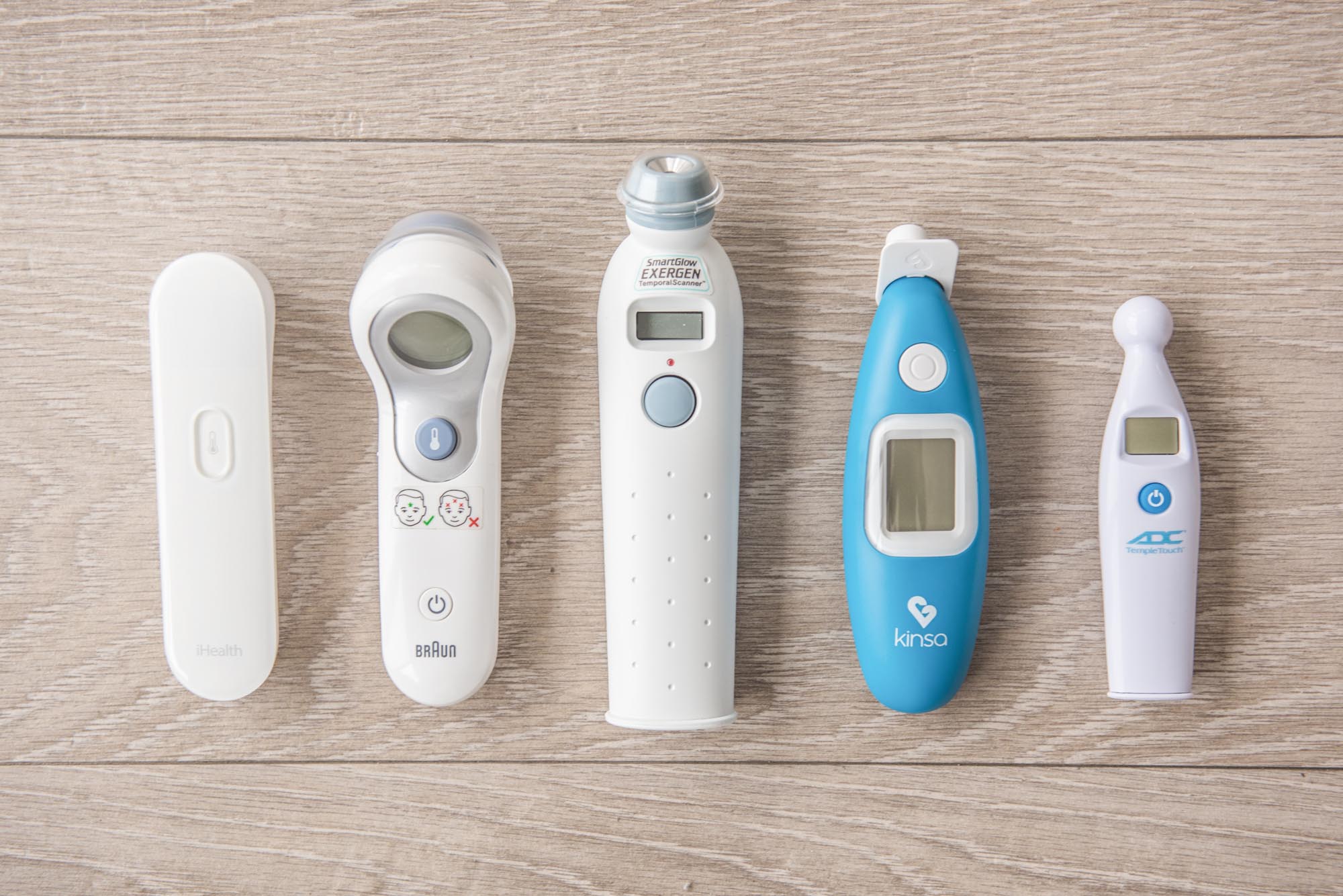
If you want the sleekest and simplest thermometer, the iHealth – PT3 non-contact forehead thermometer will be sure to impress. The iHealth only has one button and one reading mode, and it even uses a vibration motor rather than a beeper to tell you when it finishes checking. It’s not as versatile as the iProven, though, since it only gives you one method of scanning. It was also slightly less consistent than the Motorola in our tests.
The Braun – NTF300US was the first popular non-contact forehead thermometer, and it’s probably the model that gave us the most mixed results. Braun seems to have developed an updated model, but it’s not easy to find for sale. In our tests, the 300 model displayed a temperature a full degree below most others, though it was quite consistent. For the price, its poor reputation is too much of a risk when the other non-contact models we tested gave us the readings we expected to see.
If you want something that’s closer to a design tested in clinics and hospitals, the Exergen – TAT200c SmartGlow is based on a best-selling professional model. The display is very small, though. About the only major benefit this model has over the others we tested is a comprehensive instruction booklet, including suggestions for ways to verify forehead readings by checking behind the ear.
For those who need a smartphone app and don’t trust forehead readings, the Kinsa – Smart Ear Thermometer gives you Bluetooth-connected record-logging along with the accuracy of an eardrum measurement. In our tests, though, we didn’t see much reason to prefer ear readings, and the app doesn’t do anything more than a notepad would.
The only forehead scanner we found that uses touch, rather than infrared sensing, the ADC – Temple Touch is an inexpensive alternative. The metal contact patch has to be on your forehead for about 20 seconds, but it tells you when it’s working and seems reliable. It ranked low on our list, because it’s so much slower than any of the other thermometers we tested, and it’s difficult to tell if the metal pad is making contact when you’re checking yourself.
Other probe thermometers we tested
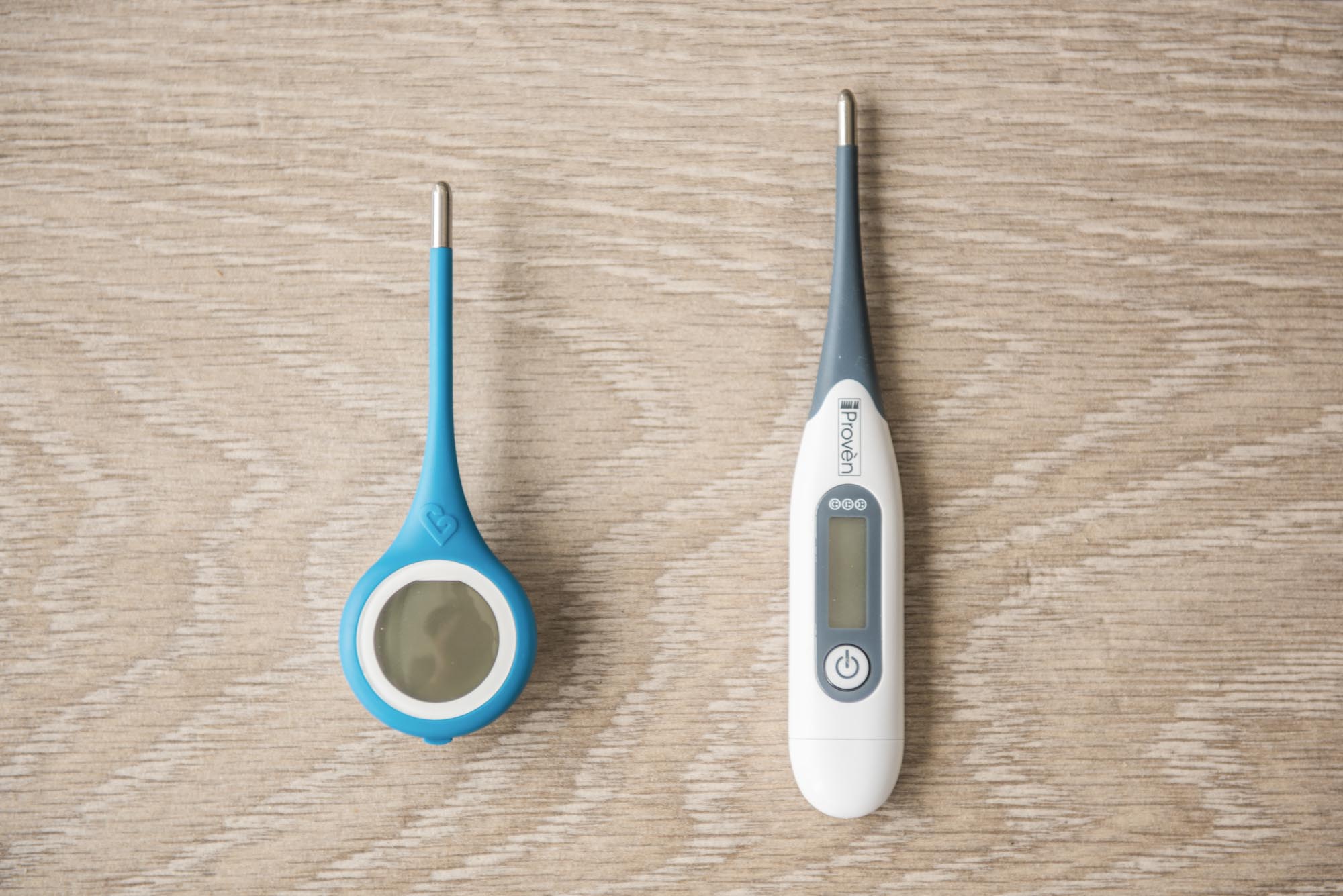
Another Bluetooth thermometer we tried was the Kinsa – QuickCare. This simple probe thermometer has a lot going for it: accurate and consistent readings that are almost as quick as the ADC and Vicks probe models, plus Bluetooth if you want to track temperatures in an app.
The Kinsa’s downside is the short display time; after just 10 seconds, the temperature display resets. If you’re using the app that’s not a problem, but it could be annoying if you don’t check right away. The button is also harder to press than on the other probe thermometers.
Our final probe thermometer is the iProven DT-R1221AWG. It’s not much different than the ADC overall: It takes about as long to read a temperature, and it was a tiny bit more accurate in our tests. The display is smaller, though, and it wasn’t as consistent between tests. This isn’t a bad thermometer, but the ADC is a few dollars cheaper.
The bottom line
Getting an easy-to-use thermometer to measure fever symptoms is an essential part of stocking your medicine cabinet. You want a model that is accurate and consistent but isn’t difficult to use.
Different bodies work at different temperatures, over a range of about two-and-a-half degrees Fahrenheit. Whatever thermometer you get, it’s important to test it and learn how it works when you aren’t running a temperature, so you’ll know exactly how much hotter you’re running if you get sick.
The iProven – DMT-511 was the best forehead and ear thermometer for kids and adults, since it gives you two different reading modes that will help you verify if you’re getting the right numbers with your technique. It’s also easy to mute if you don’t want to disturb your sleeping sicky.
If you need to check a baby’s or small toddler’s temperature, it can be frustrating to get them to sit still even for a few seconds. That’s when an instant-scan touchless forehead thermometer like the Motorola – MBP70SN makes life better. The Bluetooth functions can help you track temperatures and remember medications, but they don’t get in the way of basic temperature checks.
Finally, if you’re looking for a basic, affordable thermometer to pop under your tongue without worrying about aiming a forehead thermometer or ear wax interfering with an ear scan, the ADC – Adtemp 418N is quick, reliable and easy to read.
More Reviews
The Best Soaps for Sensitive Skin
CeraVe - Hydrating Body Wash
Parent's Choice
JuJuBe - B.F.F.
Contours - Options Elite
Britax - B-Safe Ultra
LÍLLÉbaby - Complete All Seasons
Infant Optics - DXR-8
Nuk - Magic 360
The 7 Best White Noise Machines
ASTI - 'LectroFan
Serenilite
SPRI - High Density Roller


